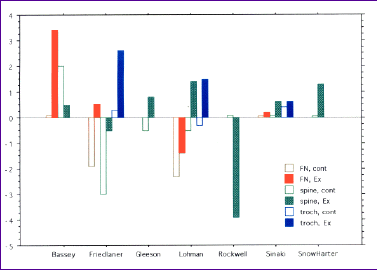Exercise
Physical activity
Active women who get more exercise have a lower risk of hip fracture than sedentary women. This may be due to effects of exercise on the skeleton or to decreasing the risk of high impact with a fall. It also may be a reflection of the fact that healthier people are more likely to be active. Controlled studies do show a benefit from exercise, but in many of the studies over half the subjects stopped the program within a year. Walking is a weight-bearing activity that women can do thier entire life, and it does not require any extra expensive equipment. Therefore I recommend walking for prevention of hip fractures. Back extension exercises and Tai Chi also are beneficial.
note: the rest of this page needs updating, there have been quite a few recent reports about effects of exercise.
Interventions in premenopausal women

Interventions in postmenopausal women
The reported studies of exercise intervention suggest that it is beneficial, but the magnitude of the bone density response is small. Motivation to continue the exercise program is difficult. One study found that women who took estrogen and exercise had better improvement in bone mass than either therapy alone.
Here is a table describing study results of exercise interventions in postmenopausal women. The results are also shown in the following graph:
 EXERCISE: controlled trials that reported bone density in each group. The results of the controls are plotted vs the results of the treated subjects, so that the points that fall ABOVE the diagonal line represent studies in which the treatment group was BETTER than the control group. The size of the point is proportional to the number of subjects in the study.
EXERCISE: controlled trials that reported bone density in each group. The results of the controls are plotted vs the results of the treated subjects, so that the points that fall ABOVE the diagonal line represent studies in which the treatment group was BETTER than the control group. The size of the point is proportional to the number of subjects in the study.
Interventions in elderly women
Women in nursing homes were randomly assigned to a program of walking, and after four years they had significantly better bone density than women in the control group. Even frail skeletons can respond to exercise. It is important to assure adequate calcium intake as well.
Physical therapy
After a fracture has healed, physical therapy is helpful to instruct in back extension exercises and back care. Gentle back extension exercises can help improve posture and pain. Gait training also may help some women.
Specific exercises
The skeleton responds better to weight bearing activity (walking and lifting weights) than to aerobic activity without weight bearing (swimming, bicycle riding). Walking is often recommended because it is an activity that can be readily incorporated into a daily routine. Recent studies have shown a beneficial effect of Tai Chi.
Skeletal response to mechanical forces
Elegant animal studies have shown the importance of mechanical loading to the skeleton. Removal of the muscle will result in rapid loss of bone, which can be restored by compressive loading. The bone responds better to high loads of low frequency than to frequent low loads.
Bedrest experiments have shown that absolute bedrest results in very rapid skeletal loss. This is seen in patients with spinal cord injury. However, as little exercise as going to the bathroom is sufficient to prevent the rapid loss.

Lanyon, L. E.(1986). Modulation of bone loss during calcium insufficiency by controlled dynamic loading. Calcif Tissue Int 38(4): 209-16.
Updated 1/22/04, reviewed 2/25/16


 EXERCISE: controlled trials that reported bone density in each group. The results of the controls are plotted vs the results of the treated subjects, so that the points that fall ABOVE the diagonal line represent studies in which the treatment group was BETTER than the control group. The size of the point is proportional to the number of subjects in the study.
EXERCISE: controlled trials that reported bone density in each group. The results of the controls are plotted vs the results of the treated subjects, so that the points that fall ABOVE the diagonal line represent studies in which the treatment group was BETTER than the control group. The size of the point is proportional to the number of subjects in the study.



